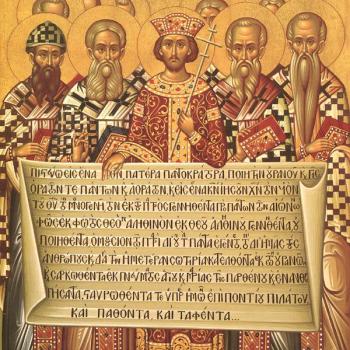
Henri de Lubac, in Paradoxes of Faith, tells us something which we must always keep in mind when we read:
When we are faced with a very great text, a very profound one, never can we maintain that the interpretation we give of it – even if it is very accurate, if need be, the only accurate one — coincides exactly with its author’s thought.[1]
What ideas inspire a writer to write the text which the they eventually write, and the interpretation of that text, though related to each other, are not one and the same. Writers realize what they write rarely, if ever, represents the notions which they wanted to express. This is why many writers do not like reading their own works, because they see the difference between what they wanted to write and what they produced. Often the difference is so great, they are embarrassed by what they see. But this means, there is a distinction, sometimes slight, sometimes great, between a given text and what it says and what its writer or writers wanted to say.
Far from representing the intended meaning of the author, a text takes a life of its own, and in the process of writing, a writer often feels the pull of the text itself take over, making the text a thing of its own. Many fiction writers talk about this in relation to the way their characters take over their stories: after the introduction of a particular character, the whole story and everything which happens in it is changed. The story soon takes shape in a way which surprises the author as its later readers. Although the author’s original ideas inspire the text, the text ends up representing something far different, and because of it, the author themselves might not realize all the intricate details of the text, and all the possible meanings which come from it. This is why we cannot limit the meaning of a text to the author’s original ideas and intent, because the author themselves find that intent has been overtaken by the text itself.
This, then, takes us to the reader. Readers engage a text, coming to it with their own knowledge and understanding, their own particular hermeneutic, one which will differ from the original author. What they get out of a text must not be confused with the author’s original understanding and intent. They do not come to the text with the same hermeneutic as the author, no matter how much they try to do so. To assert their reading is what was originally intended is foolish at best, but becomes absurd when a particular reading comes to a text in an entirely new context, one which the author could never have understood. An eighteenth century author’s understanding of the world is vastly different from a twenty-first century reader; no matter how much a twenty-first century reader might try to let the eighteenth century context influence their reading, they will still be shaped by their twenty-first century context.
No reader, therefore, can claim to hold an interpretation of text which is the same as the original author’s, nor can they hold that what the original author intended when writing a text is exactly what is found in the text itself. But, and this is also important, no text can be found to interpret itself, because once again, it takes a reader to interpret a text, and all readers have their own particular hermeneutical lens which they use when reading texts. This means different readers will come out with different meanings for the same text. This is not to say they need to be radically different: indeed, though each reader has their own particular hermeneutical lens, those lenses have many elements in common, and so will lead to many shared conclusions. The text provides an objective foundation for interpretation, but there will always be a subjective element involved with that interpretation.
The author’s original intent, though it cannot be had by a particular text, is important, because it still has an influence over the text and the formation of the text itself. All interpretations of the text are influenced by that intent, but none of them must be seen as univocal with it. The intent helps direct the text, even if the text takes on a life of its own. An author, while they are alive, likewise can answer questions and help people take on aspects of their own hermeneutical lens, helping people to come closer to their own understanding of the text. But, because the text is not entirely the same with what the author intended, the meaning of the text is not limited to the author’s original viewpoint. Indeed, great texts have a depth to them which their authors do not know, and that depth is what makes them come alive, and have value beyond what the author originally intended.
de Lubac, therefore, tells us that subsequent commentary, if it is of any value, will reveal the interpreter’s understanding by making explicit what they find in the text while leaving room for the text to transcend all such particular commentary because it can be interpreted in an infinite number of ways:
In a sense, the commentary, if it is at all penetrating, always goes farther than the text, since it makes what it finds there explicit; and if it does not in fact go father, it is of no use, since no light would then be shed by it on the text. But in another and more important sense, the text, by its concrete richness, always overflows the commentary, and never does the commentary dispense us from going back to the text. There is virtually infinity in it. [2]
When dealing with texts, we can never go back to the original intention of the writer, because the text itself does not entirely follow that intention. Knowing that original intent, or at least, reconstructing it, will help us understand elements of the text, but the text is not bound to that original interpretation, even as it is not bound to any particular commentary or interpretation. Whatever particular hermeneutical lens we bring to a text will help us focus on elements of the text and so reveal them to the public, but, no matter how much light that lens gives to the text, the text still has many other ways it can be interpreted, and so many other ways in which its secrets can be revealed. This, however, shows us how and why we cannot rely upon the text to interpret itself. If we could, there would be no need for commentary, and there would be no debate as to what the text means. No text, however, speaks for itself – it comes to us and we read it and interpret it based upon our own knowledge and insights, and without that merger, the text becomes silent.
Originalism and textualism, therefore, are both false, and they are false because they represent naïve takes on texts. Originalism claims the only possible meaning of a text is that found with the author’s original interpretation of it. Textualism suggests there is no interpretive process necessary for the reading of a text, that a text speaks for itself. Those who embrace such ideologies end up using a text for their own ideological pretexts, and they do so by trying to assert the authority of the author and the text itself in ways neither can be, nor should be, asserted. No matter how much they want to claim their reading is the original intended meaning of the text, nor how the text automatically says what they believe it says, the truth of the matter is that all they have to offer is their own ideological slant to the text, and they subvert the text itself insofar as they try to force their own reading of it as being the one and only possible reading of it.
[1] Henri de Lubac, Paradoxes of Faith. Trans. Paul Simon, Sadie Kreilkamp and Ernest Beaumont (San Francisco: Ignatius Press, 1987). 109.
[2] Henri de Lubac, Paradoxes of Faith, 109.
Stay in touch! Like A Little Bit of Nothing on Facebook.
If you liked what you read, please consider sharing it with your friends and family!













